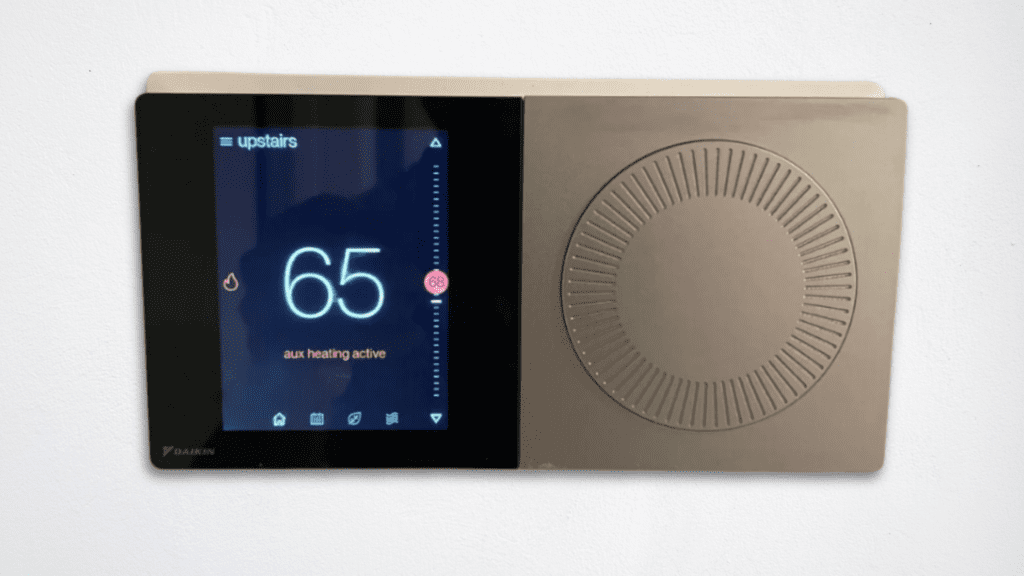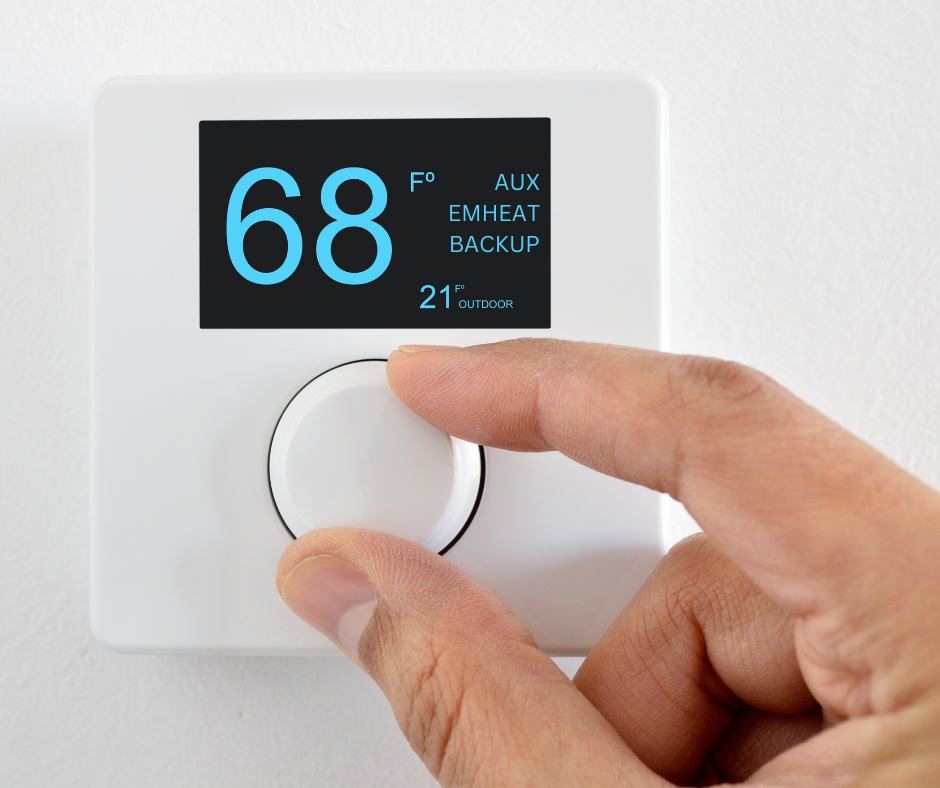Decoding HVAC Jargon: Emergency Heat, Auxiliary Heat, and Backup Electric Explained!
When temperatures drop, we understand the importance of a reliable heating system to keep you warm and cozy. But have you ever scratched your head trying to figure out the difference between emergency heat, auxiliary heat, and backup electric in your HVAC system? Don't worry, you're not alone! We’re going to break it down in simple terms to help you make smart choices this winter.
Auxiliary Heat: The Trusty Sidekick
 First, let's talk about auxiliary heat – the trusty sidekick to your electric systems that are heat pump and electric furnace. In most cases, auxiliary heat works alongside your heat pump to provide that extra boost when needed. Think of it as your HVAC system's way of saying, "I've got your back!"
First, let's talk about auxiliary heat – the trusty sidekick to your electric systems that are heat pump and electric furnace. In most cases, auxiliary heat works alongside your heat pump to provide that extra boost when needed. Think of it as your HVAC system's way of saying, "I've got your back!"
Standard heat pumps are efficient down to about 35 degrees outside. When it gets colder than that, they have a hard time keeping up on their own, so the electric furnace kicks in to assist. This furnace uses electric resistance coils to help maintain your desired indoor temperature. The colder it gets outside, the more the electric furnace runs to assist. While the electric furnace is running, some thermostats will show AUX.
Auxiliary heat is not efficient, however, so expect utility bills to be higher when it's really cold outside. However, this is some potential relief in sight: more efficient heat pumps called cold climate heat pumps have been developed more recently. They are efficient down to about 5 degrees outside, utilizing less backup electric from your electric furnace. This is great news for your utility bills!
Emergency Heat: Your HVAC Superhero
Imagine this scenario: it's the coldest night of the year, and your heating system is working overtime to keep up. Suddenly, something goes wrong—your heat pump struggles. Emergency heat to the rescue!
Emergency heat is a superhero because if a heat pump breaks down, you can use it to generate heat in your home. Keep in mind that switching the thermostat to emergency heat should only be done if you know the heat pump is not working properly. Like auxiliary heat, emergency heat can be expensive to run if your home is fully electric, so you'll want your heat pump checked out immediately.
Overall, in Indianapolis where winters can yo-yo from mild to downright harsh, having a reliable emergency heat source, like a gas furnace, ensures your home stays warm and toasty even on the coldest nights.
Backup Electric: Another Name for the Same Option
Last but not least, let's talk about backup electric. This feature is like the contingency plan in case your primary heating source experiences a hiccup. For example, if your heat pump malfunctions, backup electric heat strips can step in to keep things warm while you schedule a repair.
While backup electric heat is a reliable Plan B, it's essential to use it sparingly. Electric heating can be more expensive than other options, so consider it your safety net rather than your go-to heating source.
The Difference
 So what’s the real difference between these three? In case you haven’t figured it out yet, emergency heat and auxiliary heat are technically the same thing: with both, your electric furnace is providing heat. However, with auxiliary heat, the electric furnace is assisting your system. In emergency mode, the electric furnace is running alone because the heat pump is locked out.
So what’s the real difference between these three? In case you haven’t figured it out yet, emergency heat and auxiliary heat are technically the same thing: with both, your electric furnace is providing heat. However, with auxiliary heat, the electric furnace is assisting your system. In emergency mode, the electric furnace is running alone because the heat pump is locked out.
And now you might guess that backup electric is just another term for emergency heat, auxiliary heat, or electric furnace!
So, while there’s not a huge difference between the three, it’s important that you know what these phrases mean in order to make informed decisions about your comfort during the coldest days of Indianapolis winters.
At LCS Heating and Cooling, we're here to ensure your HVAC system is in tip-top shape, ready to tackle whatever Mother Nature throws your way. If you have any questions or need assistance, contact us today – we're always happy to help our fellow Hoosiers stay warm and cozy! Stay toasty, Indy!
We've had one of the coldest winters on record here in Indianapolis so it seems everyone has spring fever! With the arrival of spring comes a whole checklist of home maintenance items just waiting to be done. Here's a list of items that you can do around your home
to tidy up and get ready for summer:
- Schedule air conditioner maintenance (you knew this would be #1 on our list, right?)
- Change the filter
- Install new batteries in thermostat
- Install new batteries in smoke and carbon monoxide detectors
- Test and dust all detectors
- Check fire extinguishers
- Inspect bathroom, kitchen, door and window caulk; re-caulk as needed
- Clean and seal deck if needed
- Inspect exterior paint and touch up as needed
- Inspect siding/masonry for damage
- Repair/replace damaged window screens
- Inspect roof for damage
- Inspect outdoor play equipment
- Inspect attic for leaks
- Inspect attic insulation
- Clean gutters
- Prune spring and summer- flowering shrubs after they bloom
- Schedule yearly septic tank inspection
- Schedule irrigation inspection
- Inspect foundation for drainage problems
- Inspect crawl space/basement for moisture issues
Preventive maintenance goes a long way. Monitoring items such as these can prevent big problems in the future! Enjoy spring!
April 8, 2014
Tips For Staying Warm in Record Breaking Cold!
It's not often that we experience negative degree weather in Indiana! This weekend sure has been fun with all the snow and new temperature experiences! Well, fun unless your furnace goes out! Here are a few quick tips to make sure that you and your family are warm and cozy inside:
- Change the filter: In Indiana, furnaces are made to effectively run down to about 3 degrees outside. In temperatures below that, you may see that your furnace falls behind a little. To help the furnace out, make sure there is a clean filter inside. If the furnace is running on a dirty filter, it will have an even harder time keeping up.
- Don't change the temperature on the thermostat: Leave your thermostat at one temperature. For example, maybe you usually keep the temperature at 70 degrees during the day but 65 degrees at night. In this weather, it's going to be hard for your furnace to make up that 5 degree difference. Turn your thermostat to a temperature setting and leave it there. If you have a programmable thermostat, put a "hold" on the desired temperature so it's not fluctuating.
- Turn the thermostat to "Emergency Heat": If you have a heat pump and electric furnace, you'll see "auxiliary" heat show on your thermostat. This is because heat pumps are inefficient in extremely cold weather so the electric furnace also runs to supplement the heat pump. With temperatures below zero, the heat pump is not helping at all, so turn the thermostat to "emergency" heat. This will manually lock out the heat pump. The electric furnace will run by itself to heat your home. Just remember to turn the thermostat back to regular heat mode when outdoor temperatures warm up a bit. You don't want the electric furnace running by itself all of the time because of the cost to run it.
- Clear snow away from the heat pump: Clear away any snow drifts from the heat pump. The snow will restrict air flow and prevent the heat pump from operating properly. It may also prevent the heat pump from going into defrost mode, meaning the heat pump could ice up.
- If your furnace does quit, call right away: It will take no time at all for the temperature inside to drastically drop if your furnace happens to quit working. Call for HVAC help right away! There are a lot of homes without heat so it may be a few hours before a technician will be at your door anyway. A delay in calling will only increase that wait time.
Feel free to contact us if you have any questions regarding your HVAC equipment! Keep an eye on our Facebook page as well for other tips and posts.
Thermostats: Basic to High Tech...The Choice is Yours!
Remember when it was a simple task to buy a child a toy? The biggest choice in deciding on a doll, for example, was the clothes it was wearing. My niece asked for a doll for Christmas, but it was a specific doll that could crawl, laugh, cry, eat and need a diaper change. I looked at dolls for what seemed to be an eternity before finally deciding on one.
Believe it or not, you might feel the same way when you look at thermostats today! Most thermostats are digital. Outside of that, there are lots of options to choose from. To make it a little less overwhelming, check out our feature breakdown below to help you make the best choice for your home or office:
Basic Thermostat: A basic digital thermostat will accurately control the temperature in your home or office. This type of thermostat has buttons which can move the temperature up and down. It is not programmable so the buttons are used to manually change the temperature as needed. It's ideal to have a thermostat that shows two readings: a set temperature (what you want it to be) and an inside temperature (what it actually is).
Programmable Thermostat: A programmable thermostat is a digital thermostat designed to allow the user to set programs to control the temperature of the house or office. There are two types of programmable thermostats:
- 5/2 Programmable: This type of programmable thermostat allows Monday-Friday to be set on one program and Saturday-Sunday to be set on another program. This is a great option for people who have a set work schedule Monday-Friday. Here is a sample program for a 5/2 thermostat: 6am temperature set to 70 degrees (comfortable when you wake up in the mornings). 8am-5pm temperature set to 65 degrees (lower temperature when no one is home to save on utility costs) 5pm-11pm temperature set to 70 degrees (comfortable while at home). 11pm-6am temperature set to 67 degrees (save on utility costs while sleeping). A different program could then be set for Saturday and Sunday when you are home during the day.
- 7-Day Programmable: This type of programmable thermostat allows a different program to be set every day of the week. This is a great option for people who have flexible work schedules. You may work from home one day, volunteer at your child's school one day and work in an office one day. This type of programming allows each day to be scheduled according to your time at home and away.
There are some additional differences to these types of programmable thermostats. A 7 day often has a touchscreen, whereas a 5/2 programmable will have buttons. Some thermostats may also show the indoor humidity level. This is a great feature to quickly know if you need to adjust your humidifier.
Wi-Fi Thermostat: This is a digital, programmable thermostat which has Wi-Fi capability so the thermostat can be controlled through a phone, tablet or computer. This is a great option for people who travel or for those that simply enjoy having the latest technology! Additional features available on a Wi-Fi thermostat compared to a programmable thermostat include weather forecast, humidity control (meaning the humidifier can be controlled through the thermostat), usage charts, and alerts. HVAC equipment manufactures are even offering Wi-Fi thermostats that can communicate with high efficient equipment. One of the biggest benefits to this is an alert that will be emailed to you if there is a problem with the system.
Technology has come a long way! What's the best fit for you? We install all types of thermostats so please don't hesitate to contact us if you have questions!
Making a Statement with HVAC in Indianapolis
We love jobs in which the homeowner or business owner wants to make a statement. Maybe their home is in a historical district and they want (or need) the home to reflect that. Perhaps the homeowner lives in a condo and wants an "industrial" feel. Maybe the homeowner has eclectic taste and wants that to shine through. Maybe the restaurant owner wants to create a specific atmosphere for his customers. Whatever the job may be, we love the creativity and challenge involved in working the heating and cooling into the master plan.
We recently completed a job for a couple that purchased a home in Fountain Square, Indianapolis. The home was in bad shape; another house beside it has actually been torn down. This couple worked with their contractor and gutted the home. While they left some things in place, such as the staircase, they opened everything else up in order to bring their vision to life. As discussions started regarding the heating and cooling, they shared the things that they viewed as most important: An industrial look on the inside, efficient and quiet equipment, and humidity control topped their list.
We came up with a plan to meet all of their wants and needs...plus a couple of other perks! The finished HVAC project includes a Lennox high efficient 17 seer heat pump with a variable speed air handler. This heat pump is so quiet that when they step out their back door, they can't hear it! A bonus to this system is that it is solar ready. In the future, they can add solar panels to their roof to power the heat pump. The Lennox communicating wifi iComfort thermostat also gives them the ability to control their HVAC equipment through their phone, tablet or computer. Many two story homes have a problem with temperature differences between the first and second floors. Their home will be zoned to drastically reduce temperature fluctuation. A whole-house humidifier was also installed to create optimal humidity levels throughout the house.
Now, on to the look. We used galvanized, exposed spiral ductwork to create the industrial look they were after. The ductwork is used in the kitchen, living room, bedrooms and halls. It matches the look of their lighting and appliances. In addition, we kept 99% of the ductwork out of unconditioned areas. This will create a lighter load on the equipment during peak hot and cold days, resulting in lower utility bills.
The transformation of this house is amazing and it was a lot of fun for us! Who said HVAC can't be functional and eye catching!?


